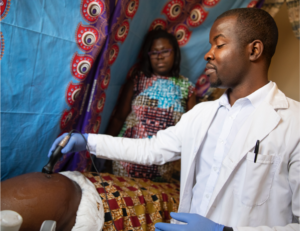Establishing accurate gestational age with ultrasound early in pregnancy is essential to delivering high-quality care.Yet, the high cost for equipment and the need for trained sonographers limits its use in low-resource settings. A new study published in NEJM Evidence introduces a novel opportunity to democratize obstetric ultrasound.
UNC investigators from the Institute for Global Health & Infectious Diseases (IGHID), UNC School of Medicine and UNC Gillings School of Global Public Health (GSPH), have developed a deep-learning artificial intelligence (AI) model that can accurately estimate gestational age using a point-of-care ultrasound (POCUS) device. Funded by the Bill & Melinda Gates Foundation, the research is part of the Fetal Age Machine Learning Initiative (FAMLI), an ongoing project that is developing technologies to expand obstetrical ultrasound access to low-income settings where cost and logistics have traditionally prevented its use.

“Ultrasound is like a stethoscope to the modern obstetrician. We use it all day, every day,” said IGHID Associate Director Jeff Stringer, MD, professor of obstetrics and gynecology, and director of UNC’s Division of Global Women’s Health. Stringer came up with the idea for the project when he and his wife Elizabeth worked as obstetricians in Lusaka, Zambia.
“These results foretell a future where all pregnant people – not just those who live in rich countries – can access the diagnostic benefits of obstetric ultrasound.”
The World Health Organization recommends an ultrasound scan before 24 weeks’ gestation for all pregnancies. The average pregnant woman in the United States receives three ultrasounds during pregnancy. People with complicated pregnancies may receive many more. Yet, in the Lusaka public sector, which is typical of care systems across sub-Saharan Africa and parts of Asia, few women have access to ultrasound at all.

Michael Kosorok, PhD, along with students and postdoctoral fellows from his lab, collaborated with Stringer on deep learning and data analysis for the study.
“I am particularly excited about the impact of this work on gestational age prediction,” said Kosorok, the W.R. Kenan, Jr. Distinguished Professor of Biostatistics in UNC GSPH.
“Because the needed hardware and training for implementing this prediction tool can be easily deployed in low-resourced settings, this has the potential to make a significantly positive impact on maternal and child health globally.”
The study, conducted from September 2018 through June 2021, recruited 4,695 pregnant volunteers in North Carolina and Zambia. The volunteers received blind ultrasound sweeps of the pregnant abdomen alongside standard fetal measurements, collected on both the commercial ultrasound machine and a low-cost, battery-powered device (Butterfly iQ). Researchers trained a neural network to estimate gestational age from the sweeps.
Three test data sets were used to assess the performance of the artificial intelligence (AI) model and standard measurements against previously established gestational age. These included a general test set comprising a random subset of study data, an IVF test set made up of women who conceived by in vitro fertilization, and a novice test set in which blind sweeps were collected by a midwife on the Butterfly iQtm battery-powered device. In each of the test sets, the AI model performed at least as well as a trained sonographer using a standard cart-based machine.
Butterfly Network, Inc (NYSE: BFLY) introduced the world’s first handheld, single probe whole-body ultrasound system using semiconductor technology in 2018. Since then, the company has sold and shipped tens of thousands of Butterfly iQ/iQ+ devices. Butterfly’s performance and lower cost model positions it as an alternative to traditional, costly cart-based ultrasound equipment and a number of other handheld devices currently on the market.

“Prior to this important research, access to low-cost imaging devices and the expertise to perform scans presented challenging hurdles to overcome in low-resource care settings. This study demonstrates the effectiveness of a unique scanning method coupled with artificial intelligence to determine gestational age by healthcare workers in Africa,” said Dr. John Martin, Chief Medical Officer, Butterfly Network. “The convergence of these advances offers hope to millions of mothers when it comes to determining risk and sequencing care. The findings of this study also reinforce our belief that mid-level practitioners, when armed with the right tools, can meaningfully improve outcomes and advance the standard of care.”
Separate from this study, and through the support of a grant from the Bill & Melinda Gates Foundation, Butterfly recently announced that it will distribute 1,000 Butterfly iQ+ devices to healthcare workers in Sub-Saharan Africa, in part, to advance maternal and fetal health.
Joni Price, MD, MPH, an assistant professor of obstetrics and gynecology at UNC who lives full time in Zambia and led study implementation at the Lusaka site, recognizes the disruptive potential of this technology. “Armed with a pocket-sized Butterfly probe and a smartphone, a Zambian midwife with no prior training in sonography can assess gestational age as accurately as a certified sonographer using an expensive machine. This has the potential to revolutionize the delivery of obstetric care in settings like Zambia.”
The team has miniaturized the AI model to run on an Android smartphone and fully integrated it into the Butterfly software. They will begin a prospective diagnostic accuracy study of the technology in Lusaka and Chapel Hill in April 2022. They are now working on other diagnostic features such as fetal presentation and amniotic fluid volume that they hope to incorporate in the future.
Other study authors include Teeranan Pokaprakarn, PhD; Juan C. Prieto, PhD; Margaret P. Kasaro, MD, MPH; Ntazana Sindano, B.Sc; Hina R. Shah, MS; Marc Peterson, MS; Mutinta M. Akapelwa, BSc; Filson M. Kapilya, BSc; Yuri V. Sebastião, PhD; William Goodnight, MD, MS; Elizabeth M. Stringer, MD, MSc; Bethany L. Freeman, MPH, MSW; Lina M. Montoya, PhD; Benjamin H. Chi, MD, MSc; Dwight J. Rouse, MD, MSPH; Stephen R. Cole, PhD; and Bellington Vwalika, MD, MSc.
To read the full study, “AI Estimation of Gestational Age from Blind Ultrasound Sweeps in Low-Resource Settings,” please visit NEJM Evidence.
About the Institute for Global Health & Infectious Diseases
Established in 2007, the Institute for Global Health & Infectious Diseases (IGHID) brings transformative solutions to the most important global health issues of our time, through research, training and service. IGHID has saved millions of lives and shaped policy worldwide through evidence-based research, especially in the areas of HIV, Malaria and now COVID, where UNC is the most cited university in the nation for coronavirus research. Working in over 50 countries around the globe, IGHID provides a unique pan-university framework for collaboration and access to research funding. It is this framework that continues to catalyze a global health community committed to improving health worldwide while providing critical training to thousands of health professionals.
